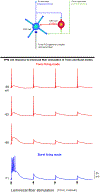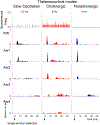Vibrissal thalamic modes
- PMID: 37220554
- PMCID: PMC10201977
- DOI: 10.4249/scholarpedia.7278
Vibrissal thalamic modes
Abstract
A thalamic mode (or thalamocortical mode) refers to a particular arrangement of the response properties of the thalamocortical network that gives rise to a distinct input-output function. Since the thalamus controls the flow of information to the neocortex, a thalamic mode adjusts how thalamocortical cells relay sensory and corticothalamic information. Thalamic modes can change on a moment-to-moment basis due to the actions of neuromodulators and/or excitatory and inhibitory inputs. In the vibrissal system, thalamic modes lead to robust changes on how sensory information from the vibrissa is processed temporally, integrated spatially and relayed to the neocortex.
Figures



Similar articles
-
Passive Synaptic Normalization and Input Synchrony-Dependent Amplification of Cortical Feedback in Thalamocortical Neuron Dendrites.J Neurosci. 2016 Mar 30;36(13):3735-54. doi: 10.1523/JNEUROSCI.3836-15.2016. J Neurosci. 2016. PMID: 27030759 Free PMC article.
-
Shaping somatosensory responses in awake rats: cortical modulation of thalamic neurons.Brain Struct Funct. 2018 Mar;223(2):851-872. doi: 10.1007/s00429-017-1522-z. Epub 2017 Oct 9. Brain Struct Funct. 2018. PMID: 28993883
-
Two classes of excitatory synaptic responses in rat thalamic reticular neurons.J Neurophysiol. 2016 Sep 1;116(3):995-1011. doi: 10.1152/jn.01121.2015. Epub 2016 Jun 8. J Neurophysiol. 2016. PMID: 27281752 Free PMC article.
-
Dynamics of sensory thalamocortical synaptic networks during information processing states.Prog Neurobiol. 2004 Nov;74(4):213-47. doi: 10.1016/j.pneurobio.2004.09.002. Prog Neurobiol. 2004. PMID: 15556288 Review.
-
Thalamic Circuit Diversity: Modulation of the Driver/Modulator Framework.Front Neural Circuits. 2016 Jan 12;9:86. doi: 10.3389/fncir.2015.00086. eCollection 2015. Front Neural Circuits. 2016. PMID: 26793068 Free PMC article. Review.
Cited by
-
The Orienting Reflex Reveals Behavioral States Set by Demanding Contexts: Role of the Superior Colliculus.J Neurosci. 2023 Mar 8;43(10):1778-1796. doi: 10.1523/JNEUROSCI.1643-22.2023. Epub 2023 Feb 7. J Neurosci. 2023. PMID: 36750370 Free PMC article.
References
-
- Bourassa J; Pinault D and Deschenes M (1995). Corticothalamic projections from the cortical barrel field to the somatosensory thalamus in rats: A single-fibre study using biocytin as an anterograde tracer. European Journal of Neuroscience 7: 19–30. - PubMed
-
- Brown RE; Stevens DR and Haas HL (2001). The physiology of brain histamine. Progress in Neurobiology 63: 637–672. - PubMed
Internal references
-
- Alonso J-M and Chen Y (2009). Receptive field. Scholarpedia 4(1): 5393. http://www.scholarpedia.org/article/Receptive_field.
-
- Bouret S and Sara SJ (2010). Locus coeruleus. Scholarpedia 5(3): 2845. http://www.scholarpedia.org/article/Locus_coeruleus.
-
- Braitenberg V (2007). Brain. Scholarpedia 2(11): 2918. http://www.scholarpedia.org/article/Brain.
-
- Freund T and Kali S (2008). Interneurons. Scholarpedia 3(9): 4720. http://www.scholarpedia.org/article/Interneurons.
-
- Hille B (2008). Ion channels. Scholarpedia 3(10): 6051. http://www.scholarpedia.org/article/Ion_channels.
External links
-
- Author’s website ( http://www.Castro-Lab.org)
-
- Sponsored by: Prof. Ehud Ahissar, Department of Neurobiology, The Weizmann Institute, Rehovot Reviewed by ( http://www.scholarpedia.org/w/index.php?title=Vibrissal_thalamic_modes&o...) : Anonymous.
-
- Accepted on: 2010-07-22 09:17:14 GMT ( http://www.scholarpedia.org/w/index.php?title=Vibrissal_thalamic_modes&o...)
Grants and funding
LinkOut - more resources
Full Text Sources
